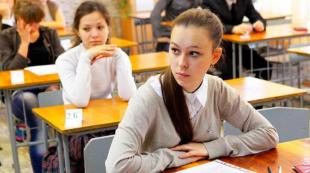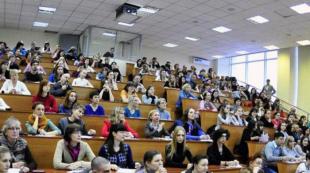Why does Rosobrnadzor hide the official USE results in specialized mathematics? Exam statistics Exam results
Results of the Unified State Examination and OGE GBOU School No. 218 for the 2016-17 academic year
The results of the final attestation of 11th grade students testify to the mastery of school graduates with the necessary level of knowledge in subjects.
Students in grade 11 took two mandatory USE (Russian language and mathematics (basic and/or profile levels)). Those who wished to take the exam in subjects of their choice. All 63 graduates were able to overcome the minimum threshold in both compulsory and elective subjects.
100 points in the Unified State Examination were received by two graduates in the Russian language, one graduate in specialized mathematics and one in biology.
|
number of those who passed in 2017 |
number of those who passed in 2016 |
min score in 2017 |
max score in 2017 |
min score in 2016 |
max score in 2016 |
|
|
basic math |
||||||
|
profile mathematics |
||||||
|
Russian language |
||||||
|
geography |
||||||
|
literature |
||||||
|
biology |
||||||
|
social science |
||||||
|
Informatics |
||||||
|
English language |
||||||
As in previous years, graduates take all possible subjects at the final certification (except for German, French, Spanish and Italian). At the same time, it is noteworthy that in 2017 attention to the subjects of the natural science cycle and exact disciplines (mathematics of the profile level, physics, biology and chemistry) increased significantly compared to 2016, and attention to the subjects of the humanitarian cycle (history, English and social science). The number of students choosing computer science for the exam is about the same as in the previous year. Geography is traditionally taken by one or two people at school.
A comparative analysis of the minimum and maximum scores in subjects over two years shows that in most subjects the minimum score has increased, in some cases significantly (in chemistry by 17 points, in computer science by 22 points), this is due to the fact that both subjects were studied in graduation 2017 at a higher level. The only subject in which the minimum result for the USE in 2017 is significantly lower than in the previous one is English (12 points lower). The reasons for this result will need to be analyzed. As for the maximum results, they are approximately the same in both parallels. True, in 2017 it is significantly lower than 100-point results (4 instead of 9).
Most of the graduates who took the exam, gaining from 60 points and above in each passed subject.
The number of graduates who scored 220 points and more in three exams is 47 people.
The number of graduates who scored in the three exams in the range from 191 to 219 points is 10 people.
The number of graduates who scored in the three exams in the range from 161 to 189 points is 2 people.
Three students took only two exams, not counting the basic mathematics, their total scores for 2 exams, ranging from 161 to 189 points.
One student did not score 160 points.
Grade 9 students took four OGEs: two compulsory (mathematics, Russian) and two optional subjects.
One student was not allowed to the final certification of the 9th grade due to the presence of academic failure (non-certification in all academic subjects).
79 students of grade 9 successfully passed the exams in the OGE format, demonstrating a good quality of preparation.
Pupils of the 9th grade received the maximum scores for 6 subjects:
- ten students in Russian language ,
- one student of literature ,
- three students in informatics ,
- three students in chemistry ,
- one student of social science.
Among the subjects of choice, students were divided into 9 different subjects (all of the possible subjects that are taught at school).
Not a single student in any subject of the OGE not received rating "2".
|
number of handing over |
||||||
|
mathematics |
||||||
|
Russian language |
||||||
|
Informatics |
||||||
|
chemistry |
||||||
|
literature |
||||||
|
social science |
||||||
|
biology |
||||||
|
story |
||||||
|
English language |
||||||
|
physics |
||||||
|
geography |
If we analyze the results based on the 4th exams, then:
20 points out of 20 were scored by 26 students (33% of the total number of those who took the test);
19 points out of 20 were scored by 18 students (23% of the total number of those who took the test);
18 points out of 20 were scored by 16 students (20% of the total number of those who took the test);
17 points out of 20 were scored by 8 students (10% of the total number of those who took the test);
16 points out of 20 were scored by 5 students (6% of the total number of those who took the test).
Thus, 73 students scored from 16 points and above in 4 exams, which is 93% of 9th grade graduates.
For graduates of the 11th grade (USE), students and their parents have a lot of questions, many of which are not conveyed in an accessible form to the understanding of the public. Today we will talk about the key points: how the exam works, why it is needed, and most importantly, how long the USE result is valid, which will be especially useful for people who for some reason did not enter a higher educational institution after graduation or wished to change institute.
What is the USE?
Before proceeding directly to the features of the unified state exam and the question of how long the USE result is valid, it is necessary to establish what it is in general and why it was introduced. The Unified State Examination is the final final attestation conducted in a universal form and mandatory for graduates of all Russian schools.
The participants who need to confirm their knowledge of the secondary school course by at least a satisfactory passing of the exam include not only ordinary graduates of schools in the Russian Federation, but also foreign citizens, refugees and migrants, categories of stateless persons who, nevertheless, graduated from school in Russia.
Required subjects
There are two compulsory subjects for passing - this is mathematics and Russian. It is for them that it is necessary to score a number of points equal to or exceeding the minimum threshold established by the Russian Ministry of Education (Minobrom). The received certificate (certificate) will indicate the positive results obtained (if they are negative, then the certificate is simply not issued) both in compulsory subjects and in additional ones, which the student chooses at his own discretion. There can be an unlimited number of the latter (at least all of them), however, for each student, an application must be submitted within the time limits established by the rules.
At the same time, students are often not interested in how long the USE result is valid or how it will affect the future life of the graduate, but in how the knowledge control procedure changes annually. This is a really important point, because reforms and innovations are regularly observed in the USE system.

A number of must-see innovations
Today, it is no secret to anyone that metal detectors, examinations of students for the presence of cheat sheets and technical communication means are commonplace in the structure of the unified state exam. The USE is indeed conducted in a strict form that requires graduates to discipline and understand the seriousness of what is happening. However, new points appear here, which make the children more and more afraid.
So, the 2017 reform already affects the subjects themselves: it is planned to add another one to the mandatory ones, which will relate to natural history or the exact sciences. The Ministry of Education explains this by the reluctance of students to choose such subjects as handed over material due to its program complexity, so they will have no choice: everyone will have to stop their decision on chemistry, physics, biology, social studies or another item from the list.

For the Russian language and a number of humanities, it is planned to introduce a mandatory oral part to identify the graduate's ability to coherently express thoughts in speech. In addition, the changes will also affect the English language: at first it will be introduced as an experimental compulsory subject in a number of educational institutions (obviously, language ones), and by 2022 it will gradually become mandatory for delivery in all schools in the country.
By the way, Crimea, which today is officially considered one of the components of the territory of the Russian Federation, from 2017 will also switch to a system of universal control of student knowledge, that is, the Unified State Examination. Crimean graduates will be offered all-Russian standards for conducting a unified exam.
USE is for everyone! 4th, 9th, 11th grades
The USE system itself concerns not only the 11th grade, as you might think about it initially. Soon, a similar form of checking the assimilation of the program will be introduced everywhere for students in the 4th grade (in many institutions this is still practiced today). According to the plans of the Ministry of Education, the number of subjects handed over by younger students will eventually reach 6. And a single exam called the OGE (mandatory state exam, in the past "GIA" - state final certification) for graduates of the 9th grade has existed for a long time. Therefore, as you can see, a unified state exam is introduced at all stages of education for an objective assessment of students' knowledge.
The control, passed three times for the entire school program, will help to determine at an early stage whether the student has a predisposition and abilities for the humanities or technical sciences, for which separate classes will soon appear. As a result, the training of future specialists in a certain direction will be laid literally from the school bench. As you can see, the question of how many years the USE results are valid will be relevant for graduates for a long time, because no one is going to cancel this form of exam in the country.

What about ratings?
In addition to finding an answer to the question of how long the USE result is valid, the guys are often lost and do not know what will be indicated in this very result - the grade or the number of points (there can be a maximum of 100). There is one more piece of news that is not too comforting: if earlier the exam scores, which were also translated into the grade, did not affect the grade in the certificate (issued in the period from June 20 to 30; previously, the indicator of the child’s usual academic performance in the subject was entered here), then 2017, it is the USE score that will be included in the certificate.
In other words, if earlier a student could get an exam three in the Russian language, but studied steadily at four, then in the certificate he had exactly “good”. Today, in the same situation, “satisfactory” will be affixed. However, a certificate with scores will also be issued separately.

Flaws
Despite the impressive list of advantages (a universal form of passing, which puts all students in the same conditions, the possibility for talented and gifted children from the outback to escape to big cities to study, the absence of the need to take exams twice, after graduation and before entering a university, etc. d.), there are a number of significant shortcomings in the USE system.
So, parents and especially graduates themselves have to experience serious psychological stress. Schoolchildren are afraid of the Unified State Examination, which turns out to be obvious if we turn to the statistics for 2016, according to which the number of students entering universities has decreased. This is not because they were not accepted; they just didn't even try.
In addition, a significant drawback is the uniformity of the material offered at the exam: the questions are regularly repeated, which means that they test not so much knowledge as good memory, working out specific superficial topics and ignoring nuances and subtleties.
Leakage of information is another minus in the USE piggy bank. How the developers of the exam will cope with overcoming the emotional barrier among graduates and eradicating existing shortcomings is not yet clear. But it is known how long the results of the exam are valid. This is perhaps a really nice item for schoolchildren, parents and teachers.

How long are the results of the Unified State Examination (2016 and 2017)
So, finally, we can go to the cherry on the cake. In this case, the information is really encouraging: the period of validity of the received certificate is as much as 4 years! The decision to extend the validity of certificates of passing the exam was made in 2013, and before that time, for example, in 2012, the results were only valid for 1.5 years. Therefore, today any graduate can, if necessary, postpone admission to a university, and he will not need to pass the final certification again for 4 years. So, let's try to calculate how long the results of the USE 2016 are valid. The deadline is December 2020 only! And how long are the results of the USE 2017 valid? By analogy, we get the date: December 2021. By the way, for conscripts who have gone into the army, the validity period of the USE results has been extended for 1 year after returning from service.
Not so long ago, Rosobrnadzor published the results of the USE for 2017. The results of the USE in each calendar period testify to stable work, an objective assessment of knowledge and the effectiveness of implementing the system into work. The past testing pleased with its results.
The USE statistics in 2017 showed that the indicator of participants who scored the minimum passing score had significantly increased. This is partly due to the fact that the work of the participants is now being processed more correctly. The data is systematized and sent to educational institutions involved in improving the qualification level of teachers.
USE results 2017
This year, innovative scanning methods were tested in Russia for the first time, which made it possible to reduce the time for systematizing information and summing up. In addition, from June 9 to June 25, Rosobrnadzor conducted a survey on the official website about the attitude of citizens to all-Russian testing. 7500 respondents took part in the survey.
68.6% of respondents noted that the new examination form is more practical.
To the question “Is it convenient that the results of the USE are relevant for 4 years?” 83.4% said yes and 16.6 said it didn't matter.
For 67%, it is important to have a reserve for passing the unified state exam in case of force majeure.
Most of the survey participants - 78.5% - were in favor of an open bank of tasks, explaining this by the fact that it is more convenient to prepare in this way.
Statistics show that 62% prefer to take their exams in writing, and 38% prefer the form of an interview.
64% of respondents noted the importance of the personality of the examiner - they would like to take the exam to the teacher with whom good relations have been established during their studies.

51.8% of schoolchildren believe that the obtained rating is sufficient for admission, while 48.2% recognize the need to introduce profile tests at the chosen university.
Importantly, 52.5% of respondents believe that the new admission procedure will equalize the chances of applicants, the remaining 47.5% assure that the content and motives are important, and not the form of examinations.
Rosobrnadzor emphasizes that the reform of the education system is aimed not only at a qualitative assessment of students' knowledge. As you know, for most schoolchildren, exams are a serious stress, but the changes have made the assessment of knowledge more comfortable and objective. To help those who are just preparing to pass the unified state exam, courses to prepare for the USE 2018 from our educational center, school knowledge and answers to the USE 2017 will come.
The end of school is the beginning of a new stage in everyone. Many people want to continue their education in higher educational institutions and acquire a certain profession. According to the requirements, school graduates must pass exams in relevant subjects. The USE statistics make it possible to evaluate test results by year and identify the weakest ones in the country.
Basic Information
The USE is a unified state exam, which is held in secondary educational institutions (schools, lyceums, gymnasiums). Rosobrnadzor is responsible for their implementation. The language used is Russian. The first exams were held in 2001 in the Samara and Rostov regions. In 2008, the USE statistics numbered more than 1 million students taking exams in the country. A year later, the exam became mandatory for admission to.
The results are set on a 100-point system. It is necessary to overcome the minimum level, which is approved every year in all subjects. USE (minimum) by years:
Does the law provide for age limits? No. According to statistics, the age of those who pass the exam is different. For example, in 2016, a 78-year-old applicant wanted to enter the journalism department.
An important factor is the psychological preparation of students. There are cases when students committed because of the exam. In 2016, in the Volgograd region, a 16-year-old schoolgirl committed suicide after passing mathematics. In her suicide note, she asked to cancel the exam and no longer torture.
Required subjects
To get a certificate, students must pass the Russian language and mathematics. The remaining subjects are chosen by the students voluntarily. USE statistics by years (Russian):
Since 2015, mathematics has been divided into profile and basic levels. The first is needed for admission to universities. What are the statistics for passing the exam in mathematics? More than 6% of graduates fail to achieve the minimum score in this subject. Whereas the minimum level of the Russian language is incomprehensible for 3.7% of schoolchildren.
Application Rules
You can find out about the places of registration on the official website of local governments. Applications must be submitted by February 1st. The exam consists of 3 stages:
- early;
- basic;
- additional.
Early exams are usually taken by graduates of previous years who want to improve their results. Pupils of the current year can take exams ahead of schedule with the consent of the pedagogical council of the school.
The USE statistics for 2017 include 86,000 graduates from previous years. Individuals who do not achieve the minimum passing score in compulsory subjects may retake the exams.
How to view results
When the results are ready, they can be viewed online at ege.edu.ru. It is enough to enter the following data:
- Registration code.
- Passport data (number).
- Region.
Knowledge level
To understand whether the level of knowledge of the new generation has improved, it is necessary to compare the results of graduate exams. Statistics of USE results by years (2016–2017):
The head of Rosobrnadzor said that thanks to systematic work with weak schools, there is a decrease in the number of participants who did not overcome the minimum threshold in all subjects.
In 2017, the statistics of those taking the exam counted 703 thousand people, of which 617 thousand are students of the current year. Profile mathematics was passed by 391 thousand students.
The USE statistics for 2017 in Russia also show an improvement in results. The average score in specialized mathematics increased by 1 point and amounted to 47.1. The number of students who did not cope with the subject decreased by 1%.
The statistics of the average USE scores show that of the compulsory subjects, mathematics is the most difficult for students. For the past five years, the average score has been below 49 points. The maximum result was in 2013 - 48.7. In Russian, the best results were recorded in 2016. The average score was 68 points.
However, the average scores for the rest of the subjects were classified. Official sources publish little data. The USE statistics for schools and lyceums in Moscow (2015-2016) marks the top ten educational institutions:
The USE statistics for schools gives the first place to the lyceum of the Research Institute Higher School of Economics. In second place - Lyceum No. 1535. The top three in terms of the number of graduates is closed by center No. 57.
Indicators by region
The USE statistics by region show different results. The economic condition affects the level of knowledge of students. Not many people can afford to study with a tutor. In some regions, schools are poorly funded. Therefore, qualified teachers leave from there.
This trend is observed not only in Russia. For example, according to the results of the EIT in Ukraine, only 28.4% of city school graduates have a high level of knowledge. While in rural areas the figure is 8%. The statistics of the USE results show that economic and educational characteristics determine the final scores by 64% in the Russian language and by 53% in mathematics.
The lowest grades are received by students from schools in the Far East. Profile mathematics is well passed in the Perm Territory and Udmurtia. But the highest scores in the Russian language are received by graduates of the Orenburg region. Good grades are also received in St. Petersburg and Perm. Whereas in Dagestan the number of students who scored 100 points increased.
Recently, a new wave of the unified state exam has started, and for those 8 years that the USE has been in a mandatory mode, the controversy around it has not subsided. In this material, we attempt to show the dynamics of the average USE scores in the Russian language and mathematics in the regions, as well as explain what regional differences in exam results may be related to.
The data presented here is collected from open sources. The results of the USE were obtained from the regional websites of educational departments and centers for assessing the quality of education. Other indicators are collected on the websites of the Ministry of Education and Science of the Russian Federation, Rosstat, and the Federal Treasury.
USE results: regional differences
If you look at the map, you can see that the highest average scores in both the Russian language and mathematics show the regions of the Central Federal District. In 2015, the leaders in the Russian language were the Orenburg and Samara regions, as well as the Perm Territory, in profile mathematics - the Republic of Kalmykia, the Perm Territory and Udmurtia. The lowest results, contrary to stereotypes, are observed not in the North Caucasian regions, but in the Far East.
.jpg)
.jpg)
Of particular interest is the dynamics of the USE results in the regions. It is incorrect to compare scores by years directly - over the years, the exam has experienced many changes. For example, in 2013, during the massive leaks of answers, the scores of participants in the whole country were higher, and in 2014, after tightening security measures, they fell. With this in mind, we looked at the position of the regions relative to the average score in Russia and used standardized z-scores. In other words, we compared the dynamics of the regions relative to the national average. The results of the regions in 2010 and 2014 were compared, since during this period the content and structure of the exam were the most stable.
.jpg)
.jpg)
In general, a significant (more than one standard deviation) growth over these five years was demonstrated by 16 subjects of the Russian Federation in mathematics, and 11 subjects of the Russian Federation in the Russian language. Basically, these are the regions that in 2010 showed results below the average. A serious decrease in scores occurred in mathematics in 6, and in the Russian language in 3 regions - where in 2010 there were quite high scores. In the subjects of the Russian Federation with average results, there were no significant changes in scores.
Factors of Regional Differences in USE Results
2009-2014:
In order to understand what explains the results of the USE in mathematics and in the Russian language in 2009-2014, we analyzed their relationship with a number of regional characteristics. The focus was, firstly, on the role of resource support for schools, and secondly, on the role of family resources.
School resources are largely determined by the amount of public funding. If per capita school funding is adjusted for inflation and differences between regions in the cost of living, then the increase in this indicator from 2006 to 2013 was about 40 percent. At the same time, the maximum gap in per capita financing over the same period slightly decreased - from 6 to 5 times. The largest increase in school funding occurred in 2012, when the “May Decrees of the President” were adopted.
Changes in school funding are important for student outcomes. According to our estimates, regions with a higher level of per capita funding show higher average USE scores in mathematics (with equal levels of economic development, incomes of the population, and a number of other characteristics of the regions). According to the Russian language, there was a significant correlation between the results of the USE and per capita funding (taking into account other regional indicators) in 2009-2014. not found. In part, this can be explained by the fact that the social characteristics of families play a large role in the results in the Russian language.
The main share in the budget financing of schools is teachers' salaries. At the same time, the dynamics of their salaries relative to the average level of wages in the region is important. In general, this trend has been positive. The most significant increase in the relative salaries of teachers was observed in 2008 and 2012-2013, with a slight decrease in 2007 and 2010.
According to our estimates, the level of teachers' salaries relative to the average salary in the region is positively associated with the regional results of the Unified State Examination in both the Russian language and mathematics. What teachers will come to schools and with what attitude they will work depends on wages. For example, data from the 2012 PISA survey of school principals shows that teachers in regions with higher relative salaries are more motivated, enthusiastic, and driven to achieve.
.jpg)
In addition to the state, families invest in the education of children. The resources of families are determined by their income. Our analysis shows that in regions with a high level of poverty (the share of people with incomes below the subsistence level), the USE results are lower. The high level of income inequality within the region also negatively affects the average USE scores (with an equal level of budgetary funding for schools and a number of other regional characteristics).
In other words, family resources are also important for improving the educational achievements of schoolchildren. At the same time, in the constituent entities of the Russian Federation with low incomes, the resources of regional budgets, and hence the funding of schools, are on average lower.
In general, at this stage, equalizing the level of budgetary funding of schools between regions is not enough to equalize the scores of children.
2015:
If we talk about the results of 2015, then the gap between the regions with the minimum and maximum average USE scores can be 28 points in the Russian language and 16 in mathematics. The socio-economic characteristics of the subjects of the Russian Federation (gross regional product, school funding per student, the share of the population with higher education, and the share of the urban population) explain the average USE score in mathematics by 25 percent and the average USE score in Russian by 34 percent. Children from less prosperous regions are less likely to score high on exams than those who live in more economically developed parts of the country. Moreover, in the Russian language, this gap is somewhat larger than in mathematics.
Almost to the same extent (28 percent in math and 30 percent in Russian) average scores in the regions are explained by the characteristics of schools and teachers. It is important to take into account how many children in the region go to college after grade 9, and how many remain in high school and take the exam. As our analysis shows, in schools where less than half of the ninth-graders remain in the upper grades, the results are also higher than in those where the selection (or self-selection) of children is less strict.
Teacher characteristics also matter. In all regions, teachers with completed higher education prevail, however, where there are more than 80 percent of such teachers, the results of the USE of students are higher. However, the relationship between the results and the category of a teacher turned out to be not so unambiguous - the highest results are among graduates in regions where the proportion of teachers with the highest category varies from 22 to 30 percent.
.jpg)
Thus, our analysis shows how unequal the chances of students from different regions for high USE scores are. By the way, the average results of Moscow schoolchildren on the Unified State Examination are 13 points higher in specialized mathematics and 5 points higher in the Russian language than those of schoolchildren from the Republic of Buryatia.
In general, the economic and educational characteristics of the regions determine the USE scores by 64 percent in the Russian language and by 53 percent in mathematics. At the same time, these factors are beyond the sphere of influence of teachers and schools themselves, so it is incorrect to evaluate them by this result.
conclusions
As our analysis shows, there are rather large regional differences in the educational results of schoolchildren in Russia. These differences can determine the future fate of children, including affecting admission to universities.
In many ways, this difference is related to the extent to which schoolchildren are provided with educational resources. Inequality of resources exists both at the level of families and at the level of public funding of schools. Often one accompanies the other.
Our analysis does not take into account variations in the scores of the unified exam within regions, although this task seems to be extremely useful in developing educational policy measures. Such an analysis requires access to anonymized USE data for researchers. In developed countries, the results of such tests are used to analyze and develop management decisions, and it is important to use this experience in Russia as well.
The USE, as an objective tool for evaluating school graduates, showed the existence of a problem with inequality in education. It is impossible to place the entire responsibility for solving this problem on the exam itself or teachers. Equalization of educational opportunities is a task of state policy.









